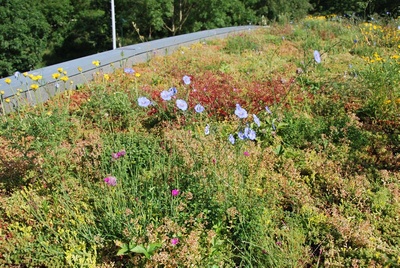Urban development over the last 50 years has led to the paving over of large areas of countryside with cities and supporting infrastructure. Even the traditional areas of parkland and green spaces within our cities have come under increasing pressure. High rise development in major cities reduces the natural airflow, adding to dirt and pollution, higher temperatures and lower humidity levels.
What is a green roof? The term green roof typically refers to a roof of a building that is partially or completely covered with vegetation and soil, or a growing medium, planted over a waterproofing membrane. This does not include roofs which are merely coloured green, as with green shingles. Green roofs often include additional layers such as a root barrier and drainage and irrigation systems. Many specifiers and building owners are therefore turning to green roof systems, and the numerous environmental benefits that they offer:
Increased life expectancy Green roofs can significantly increase the life of the waterproofing membrane, protecting it from UV degradation and the extremes of climatic conditions.
Improved thermal performance Green roof systems are recognized as providing greater thermal performance and roof insulation for the buildings they are laid on. In addition to the thermal insulation installed as part of the waterproofing system, green roofs can further reduce the energy consumption of a building by up to 10%. Green roofs have the ability to affect the insulation properties of roofs, and can therefore also help manage the temperature of the living spaces beneath. Furthermore, the thermal insulation properties and resulting cooling of green roofs can have significant costs benefits for building owners/managers.
Improved ambient air quality Green roofs improve air quality by attracting particles to the vegetation and soil. Plants also absorb airborne pollutants through the leaves, removing them from the environment, and during the natural process of photosynthesis, plants convert carbon dioxide to oxygen, which improves the immediate air quality.
Better acoustic performance The combination of soil, plants and trapped layers of air within green roof systems can play an important part in the overall soundproofing of the building. act as a sound insulation barrier. Indicative figures suggest that a green roof can reduce sound by as much as 8dB compared with a conventional roof system*. This benefit could be particularly important in areas of high noise pollution such in the approaches to airports, as these levels are sufficient to provide noise insulation to buildings under aircraft flight paths. *Source: LivingRoofs.org.
Improved aesthetic appearance Urban development over the last 50 years has led to the paving over of large areas of countryside with cities and supporting infrastructure. Even the traditional areas of parkland and green spaces within our cities have come under increasing pressure. High rise development in major cities reduces the natural airflow, adding to dirt and pollution, higher temperatures and lower humidity levels.
Reduced storm water run-off The reduction in storm water run-off offered by green roofs is a major benefit. From the results gained by practical trials, the average extensive system can absorb approximately 50% of the rainwater falling on it, and also significantly delay the passage of the remaining water, reducing the pressure on drainage facilities and flooding. Intensive systems incorporating sufficient soil depth to support planting schemes can retain up to 75% of rainfall. Tests have also indicated that greater soil depths may retain up to 90% of rainfall.


